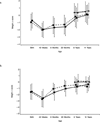Trajectory and correlates of growth of extremely-low-birth-weight adolescents
- PMID: 24216539
- PMCID: PMC3992255
- DOI: 10.1038/pr.2013.209
Trajectory and correlates of growth of extremely-low-birth-weight adolescents
Abstract
Background: Catch-up growth may predispose to obesity and metabolic sequelae. We sought to examine the trajectory and correlates of growth and catch up among extremely-low-birth-weight (ELBW) (<1 kg) adolescents.
Methods: A cohort study of 148 neurologically normal ELBW children and 115 normal-birth-weight (NBW) controls born during the period 1992-1995 was conducted. Longitudinal measures of gender-specific growth of ELBW children from birth, in addition to growth and measures of obesity of ELBW and NBW children at 14 y, were evaluated.
Results: Following neonatal growth failure, ELBW children had accelerated growth, but at 8 y, they still had lower weight and height z scores than NBW children. By 14 y, ELBW boys had caught up in growth to their NBW controls, but ELBW girls remained significantly smaller. ELBW children, however, did not differ from their controls in measures of obesity. In hierarchical multiple regression analyses, only maternal BMI and weight gain during infancy and childhood predicted the ELBW children's 14-y weight z scores, BMI z scores, and abdominal circumference. Perinatal risk factors, including intrauterine growth, only predicted growth up to 20 mo.
Conclusion: Maternal BMI and rate of growth, rather than perinatal factors, predict 14-y obesity among neurologically normal ELBW adolescents.
Conflict of interest statement
Figures


References
-
- Hack M, Schluchter M, Cartar L, Rahman M, Cuttler L, Borawski E. Growth of very low birth weight infants to age 20 years. Pediatrics. 2003;112:e30–e38. - PubMed
-
- Saigal S, Stoskopf B, Streiner D, Paneth N, Pinelli J, Boyle M. Growth trajectories of extremely low birth weight infants from birth to young adulthood: A longitudinal, population-based study. Pediatr Res. 2006;60:751–758. - PubMed
-
- Lucas A. Long-term programming effects of early nutrition - Implications for the preterm infant. J Perinat. 2005;25:S2–S6. - PubMed
Publication types
MeSH terms
Grants and funding
LinkOut - more resources
Full Text Sources
Other Literature Sources
Medical

